+ Open data
Open data
- Basic information
Basic information
| Entry | Database: PDB / ID: 5wb2 | |||||||||
|---|---|---|---|---|---|---|---|---|---|---|
| Title | US28 bound to engineered chemokine CX3CL1.35 and nanobodies | |||||||||
 Components Components |
| |||||||||
 Keywords Keywords | MEMBRANE PROTEIN / chemokine receptor / engineered proteins | |||||||||
| Function / homology |  Function and homology information Function and homology informationCXCR1 chemokine receptor binding / positive regulation of calcium-independent cell-cell adhesion / negative regulation of interleukin-1 alpha production / leukocyte adhesive activation / CX3C chemokine receptor binding / negative regulation of glutamate receptor signaling pathway / autocrine signaling / lymphocyte chemotaxis / synapse pruning / positive regulation of microglial cell migration ...CXCR1 chemokine receptor binding / positive regulation of calcium-independent cell-cell adhesion / negative regulation of interleukin-1 alpha production / leukocyte adhesive activation / CX3C chemokine receptor binding / negative regulation of glutamate receptor signaling pathway / autocrine signaling / lymphocyte chemotaxis / synapse pruning / positive regulation of microglial cell migration / regulation of lipopolysaccharide-mediated signaling pathway / negative regulation of microglial cell activation / negative regulation of neuron migration / negative regulation of hippocampal neuron apoptotic process / positive regulation of transforming growth factor beta1 production / CCR chemokine receptor binding / microglial cell proliferation / positive regulation of actin filament bundle assembly / leukocyte migration involved in inflammatory response / integrin activation / C-C chemokine receptor activity / chemokine-mediated signaling pathway / eosinophil chemotaxis / C-C chemokine binding / leukocyte chemotaxis / angiogenesis involved in wound healing / chemokine activity / Chemokine receptors bind chemokines / negative regulation of interleukin-1 beta production / positive regulation of cell-matrix adhesion / neuron remodeling / positive regulation of neuroblast proliferation / positive chemotaxis / chemoattractant activity / macrophage chemotaxis / negative regulation of interleukin-6 production / negative regulation of apoptotic signaling pathway / negative regulation of tumor necrosis factor production / negative regulation of cell-substrate adhesion / negative regulation of extrinsic apoptotic signaling pathway in absence of ligand / regulation of neurogenesis / extrinsic apoptotic signaling pathway in absence of ligand / neutrophil chemotaxis / positive regulation of smooth muscle cell proliferation / negative regulation of cell migration / positive regulation of release of sequestered calcium ion into cytosol / response to ischemia / cell chemotaxis / cell projection / calcium-mediated signaling / microglial cell activation / defense response / cell-cell adhesion / positive regulation of neuron projection development / neuron cellular homeostasis / regulation of synaptic plasticity / integrin binding / cytokine-mediated signaling pathway / chemotaxis / positive regulation of angiogenesis / positive regulation of inflammatory response / antimicrobial humoral immune response mediated by antimicrobial peptide / cell-cell signaling / positive regulation of cytosolic calcium ion concentration / G alpha (i) signalling events / positive regulation of ERK1 and ERK2 cascade / positive regulation of phosphatidylinositol 3-kinase/protein kinase B signal transduction / positive regulation of canonical NF-kappaB signal transduction / cell adhesion / positive regulation of MAPK cascade / neuron projection / immune response / positive regulation of cell migration / G protein-coupled receptor signaling pathway / inflammatory response / signaling receptor binding / neuronal cell body / positive regulation of cell population proliferation / viral envelope / negative regulation of apoptotic process / perinuclear region of cytoplasm / host cell plasma membrane / cell surface / positive regulation of transcription by RNA polymerase II / extracellular space / extracellular region / membrane / plasma membrane Similarity search - Function | |||||||||
| Biological species |   Human cytomegalovirus Human cytomegalovirus  Homo sapiens (human) Homo sapiens (human)synthetic construct (others) | |||||||||
| Method |  X-RAY DIFFRACTION / X-RAY DIFFRACTION /  SYNCHROTRON / SYNCHROTRON /  MOLECULAR REPLACEMENT / Resolution: 3.5 Å MOLECULAR REPLACEMENT / Resolution: 3.5 Å | |||||||||
 Authors Authors | Jude, K.M. / Burg, J.S. / Tsutsumi, N. / Miles, T.F. / Garcia, K.C. | |||||||||
| Funding support |  United States, 1items United States, 1items
| |||||||||
 Citation Citation |  Journal: Elife / Year: 2018 Journal: Elife / Year: 2018Title: Viral GPCR US28 can signal in response to chemokine agonists of nearly unlimited structural degeneracy. Authors: Miles, T.F. / Spiess, K. / Jude, K.M. / Tsutsumi, N. / Burg, J.S. / Ingram, J.R. / Waghray, D. / Hjorto, G.M. / Larsen, O. / Ploegh, H.L. / Rosenkilde, M.M. / Garcia, K.C. | |||||||||
| History |
|
- Structure visualization
Structure visualization
| Structure viewer | Molecule:  Molmil Molmil Jmol/JSmol Jmol/JSmol |
|---|
- Downloads & links
Downloads & links
- Download
Download
| PDBx/mmCIF format |  5wb2.cif.gz 5wb2.cif.gz | 143.2 KB | Display |  PDBx/mmCIF format PDBx/mmCIF format |
|---|---|---|---|---|
| PDB format |  pdb5wb2.ent.gz pdb5wb2.ent.gz | 106.8 KB | Display |  PDB format PDB format |
| PDBx/mmJSON format |  5wb2.json.gz 5wb2.json.gz | Tree view |  PDBx/mmJSON format PDBx/mmJSON format | |
| Others |  Other downloads Other downloads |
-Validation report
| Summary document |  5wb2_validation.pdf.gz 5wb2_validation.pdf.gz | 1.2 MB | Display |  wwPDB validaton report wwPDB validaton report |
|---|---|---|---|---|
| Full document |  5wb2_full_validation.pdf.gz 5wb2_full_validation.pdf.gz | 1.2 MB | Display | |
| Data in XML |  5wb2_validation.xml.gz 5wb2_validation.xml.gz | 25.4 KB | Display | |
| Data in CIF |  5wb2_validation.cif.gz 5wb2_validation.cif.gz | 33.1 KB | Display | |
| Arichive directory |  https://data.pdbj.org/pub/pdb/validation_reports/wb/5wb2 https://data.pdbj.org/pub/pdb/validation_reports/wb/5wb2 ftp://data.pdbj.org/pub/pdb/validation_reports/wb/5wb2 ftp://data.pdbj.org/pub/pdb/validation_reports/wb/5wb2 | HTTPS FTP |
-Related structure data
| Related structure data | 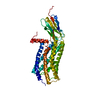 5wb1C 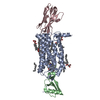 4xt1S S: Starting model for refinement C: citing same article ( |
|---|---|
| Similar structure data |
- Links
Links
- Assembly
Assembly
| Deposited unit | 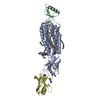
| ||||||||
|---|---|---|---|---|---|---|---|---|---|
| 1 |
| ||||||||
| Unit cell |
|
- Components
Components
-Protein , 1 types, 1 molecules B
| #2: Protein | Mass: 8631.051 Da / Num. of mol.: 1 Source method: isolated from a genetically manipulated source Source: (gene. exp.)  Homo sapiens (human) / Gene: CX3CL1 / Production host: Homo sapiens (human) / Gene: CX3CL1 / Production host:  Trichoplusia ni (cabbage looper) / References: UniProt: Q6I9S9, UniProt: P78423*PLUS Trichoplusia ni (cabbage looper) / References: UniProt: Q6I9S9, UniProt: P78423*PLUS |
|---|
-Antibody , 2 types, 2 molecules AD
| #1: Antibody | Mass: 52158.414 Da / Num. of mol.: 1 Source method: isolated from a genetically manipulated source Source: (gene. exp.)   Human cytomegalovirus, (gene. exp.) Human cytomegalovirus, (gene. exp.)  Gene: US28 / Cell line (production host): HEK293F / Production host:  Homo sapiens (human) / References: UniProt: Q80KM9, UniProt: P69333*PLUS Homo sapiens (human) / References: UniProt: Q80KM9, UniProt: P69333*PLUS |
|---|---|
| #3: Antibody | Mass: 14151.589 Da / Num. of mol.: 1 Source method: isolated from a genetically manipulated source Source: (gene. exp.) synthetic construct (others) / Production host:  |
-Non-polymers , 4 types, 8 molecules 
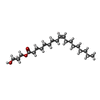

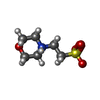



| #4: Chemical | | #5: Chemical | ChemComp-OLC / ( #6: Chemical | ChemComp-ZN / | #7: Chemical | ChemComp-MES / | |
|---|
-Experimental details
-Experiment
| Experiment | Method:  X-RAY DIFFRACTION / Number of used crystals: 1 X-RAY DIFFRACTION / Number of used crystals: 1 |
|---|
- Sample preparation
Sample preparation
| Crystal | Density Matthews: 2.59 Å3/Da / Density % sol: 52.54 % |
|---|---|
| Crystal grow | Temperature: 293 K / Method: lipidic cubic phase / pH: 6 Details: MES pH 6.0, 50 mM lithium sulfate, 35-39% PEG300, 1% 1,2,3-heptanetriol in monoolein:cholesterol (9:1) |
-Data collection
| Diffraction | Mean temperature: 100 K |
|---|---|
| Diffraction source | Source:  SYNCHROTRON / Site: SYNCHROTRON / Site:  APS APS  / Beamline: 23-ID-D / Wavelength: 1.03323 Å / Beamline: 23-ID-D / Wavelength: 1.03323 Å |
| Detector | Type: DECTRIS PILATUS3 S 6M / Detector: PIXEL / Date: Aug 7, 2016 |
| Radiation | Monochromator: double crystal Si(111) / Protocol: SINGLE WAVELENGTH / Monochromatic (M) / Laue (L): M / Scattering type: x-ray |
| Radiation wavelength | Wavelength: 1.03323 Å / Relative weight: 1 |
| Reflection | Resolution: 3.5→50 Å / Num. obs: 10361 / % possible obs: 99.5 % / Redundancy: 5.3 % / Biso Wilson estimate: 65.336 Å2 / CC1/2: 0.986 / Rmerge(I) obs: 0.026 / Rpim(I) all: 0.0289 / Net I/σ(I): 5.24 |
| Reflection shell | Resolution: 3.5→3.59 Å / Redundancy: 5.5 % / Rmerge(I) obs: 1.261 / Mean I/σ(I) obs: 1.2 / Num. unique obs: 762 / CC1/2: 0.506 / Rrim(I) all: 1.395 / % possible all: 100 |
- Processing
Processing
| Software |
| ||||||||||||||||||||||||||||||||||||||||||||||||||||||||
|---|---|---|---|---|---|---|---|---|---|---|---|---|---|---|---|---|---|---|---|---|---|---|---|---|---|---|---|---|---|---|---|---|---|---|---|---|---|---|---|---|---|---|---|---|---|---|---|---|---|---|---|---|---|---|---|---|---|
| Refinement | Method to determine structure:  MOLECULAR REPLACEMENT MOLECULAR REPLACEMENTStarting model: PDB entry 4XT1 Resolution: 3.5→45.374 Å / SU ML: 0.53 / Cross valid method: FREE R-VALUE / σ(F): 1.34 / Phase error: 28.28
| ||||||||||||||||||||||||||||||||||||||||||||||||||||||||
| Solvent computation | Shrinkage radii: 0.9 Å / VDW probe radii: 1.11 Å | ||||||||||||||||||||||||||||||||||||||||||||||||||||||||
| Refinement step | Cycle: LAST / Resolution: 3.5→45.374 Å
| ||||||||||||||||||||||||||||||||||||||||||||||||||||||||
| Refine LS restraints |
| ||||||||||||||||||||||||||||||||||||||||||||||||||||||||
| LS refinement shell |
|
 Movie
Movie Controller
Controller





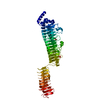
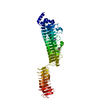

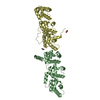
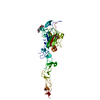

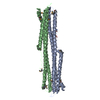
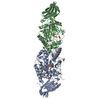
 PDBj
PDBj


















